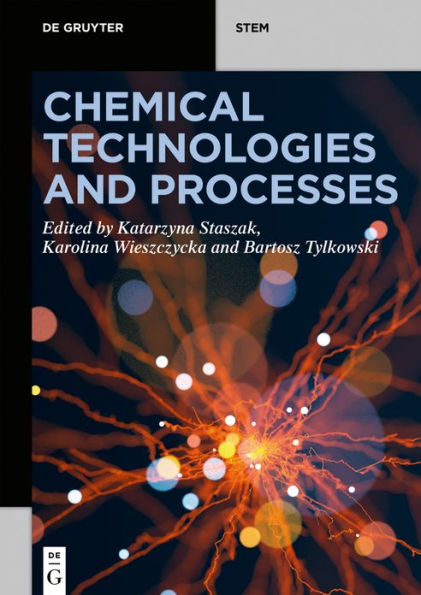Chemical Technologies and Processes / Edition 1 available in Paperback

Chemical Technologies and Processes / Edition 1
- ISBN-10:
- 3110656272
- ISBN-13:
- 9783110656275
- Pub. Date:
- 07/20/2020
- Publisher:
- De Gruyter
- ISBN-10:
- 3110656272
- ISBN-13:
- 9783110656275
- Pub. Date:
- 07/20/2020
- Publisher:
- De Gruyter

Chemical Technologies and Processes / Edition 1
Paperback
Buy New
$104.99Overview

Product Details
| ISBN-13: | 9783110656275 |
|---|---|
| Publisher: | De Gruyter |
| Publication date: | 07/20/2020 |
| Series: | De Gruyter STEM |
| Pages: | 312 |
| Product dimensions: | 6.69(w) x 9.45(h) x 0.00(d) |
| Age Range: | 18 Years |
About the Author
Table of Contents
Preface v
List of contributing authors xiii
1 Inorganic acids - technology background and future perspectives Filip Ciesielczyk 1
1.1 Introduction 1
1.2 Sulfuric acid 4
1.3 Nitric acid 14
1.4 Phosphoric acid 24
1.5 Summary 29
References 29
2 Innovative processes in the production of inorganic bases and derived salts of current interest F. J. Alguacil J. I. Robla 33
2.1 Introduction 33
2.2 Ammonia [1,1-10] 34
2.2.1 Conventional steam reforming 35
2.2.2 Partial oxidation of heavy oils 40
2.2.3 Modern conventional flow-sheets 41
2.2.4 The future 49
2.3 Sodium hydroxide [11-14] 49
2.3.1 Membrane cell process (the most widely used) 50
2.3.2 Diaphragm cell process 51
2.3.3 Mercury cell process 51
2.4 Potassium hydroxide 53
2.5 Salts [15-24] 53
2.5.1 Ammonium nitrate (AN) and calcium ammonium nitrate (CAN) 53
2.5.2 Sodium carbonate 59
2.5.3 Potassium carbonate 59
2.5.4 Lithium carbonate 60
References 63
3 Technology of simple hydrocarbon intermediates Magdalena Regell-Rosocka 65
3.1 Introduction 65
3.2 Steam cracking 66
3.3 Methanol-to-olefins (MTO) process 71
3.4 Dehydrogenation of alkanes 76
3.4.1 Catofin and Catadiene (Houndry) processes 81
3.5 Oleflex process 84
3.5.1 Other dehydrogenation processes 86
3.6 Metathesis of olefins to propylene 90
3.7 Summary 92
References 93
4 Technology of large volume alcohols, carboxylic acids and esters Martyna Rzelewska-Piekut Magdalena Regel-Rosocka 101
4.1 Introduction 101
4.2 Technology of large volume alcohols 102
4.2.1 Methanol 102
4.2.2 Ethanol 113
4.2.3 Production of bioethanol 116
4.3 Technology of large volume carboxylic acids 127
4.3.1 Acetic acid 127
4.3.2 Lactic acid 132
4.4 Technology of large volume esters 135
4.4.1 Fatty acid methyl esters - biodiesel 135
4.5 Summary 139
References 139
5 Trends in technology of oxygen containing hydrocarbons: aldehydes, ketones, ethers Katarzyna Materna 147
5.1 Introduction 147
5.2 Aldehydes and ketones 148
5.2.1 Nomenclature 148
5.2.2 Properties and application 149
5.2.3 Preparation 150
5.2.4 The most important aldehydes and ketones 151
5.3 Ethers 153
5.3.1 MTBE production methods 155
5.4 Green modifications for the oxidation of alcohols into carbonyl-containing products 156
5.4.1 Oxydation without solvent 156
5.4.2 Catalytic systems 157
5.4.3 Oxidations using sodium hypochlorite (bleach) 159
5.5 Conclusions 159
References 160
6 Novel technologies of nitrogen-based compounds Karolina Wieszczycka 163
6.1 Amines 163
6.1.1 Amination of alcohols 164
6.1.2 Halogenated hydrocarbon ammonolysis 169
6.1.3 Olefin amination 171
6.1.4 Reductive aldehyde and ketone amination 172
6.1.5 Hydrogenation of unsaturated amine 177
6.1.6 Aromatic amines - hydrogenation of nitro-compounds 179
6.1.7 Amination of olefin oxides 181
6.2 Nitro-compounds 183
6.3 Isocyanates 185
References 186
7 Halogened hydrocarbons - current trends Katarzyna Staszak 193
7.1 Introduction 193
7.2 Alkyl halides 195
7.2.1 Chloromethanes 195
7.2.2 Chloroalkanes with longer alkyl chain 206
7.3 Vinyl halides 207
7.3.1 Chloroethene 207
7.4 Aryl halides 213
7.4.1 Chlorinated benzenes 214
7.4.2 Oxidative chlorination of benzene 215
7.5 Acyl halides 216
7.5.1 Epichlorohydrin 216
References 219
8 Novel trends in technology of surfactants Daria Wieczorek Dobrawa Kwasniewska 223
8.1 Anionic surfactants 224
8.1.1 Soap 224
8.1.2 Linear alkylbenezene sulfonates (LAS) 226
8.1.3 Methyl ester sulfonate 226
8.1.4 Alcohol sulfates 228
8.1.5 Alcohol ethoxysulfates 230
8.1.6 Sulfosuccinates 231
8.2 Amphoteric surfactants 231
8.3 Cationic surfactants 234
8.3.1 Alkanolamine esters (esterquats) 234
8.3.2 Cationic surfactants based on alkylamines 234
8.4 Nonionic surfactants 236
8.4.1 Polyoxyethylene surfactants 236
8.4.2 Alkyl phenol ethoxylates 240
8.4.3 Fatty acid ethoxylates 240
8.4.4 Sorbitan esters/ethoxysorbitan esters 241
8.4.5 Alkanolamides 243
8.4.6 Amine ethoxylates 243
8.4.7 Blockpolimer surfactants 244
8.4.8 Alkyl glucoside 244
8.5 Biosurfactants 247
References 249
9 Process simulation approach in computer aided industrial design Maciej Staszak 251
9.1 Introduction 251
9.2 Physical and chemical properties 253
9.3 Creating the flowsheet and streams definition 255
9.3.1 Flash calculations 257
9.3.2 Dealing with flash numerical problems 258
9.4 Chemical reaction 259
9.4.1 Thermal modes 260
9.4.2 Chemical conversion approach 261
9.4.3 Equilibrium approach 261
9.4.4 Thermodynamic approach 263
9.4.5 Kinetic approach 264
9.5 Separation by distillation 272
9.5.1 General column setup 272
9.5.2 Process parameters 273
9.5.3 Notes 274
9.6 Heat exchangers 276
9.6.1 Given process and utility streams, one thermal degree of freedom case 277
9.6.2 Given one inlet stream and other to be calculated, two thermal degrees of freedom 277
9.6.3 Given heat transfer coefficient and area of exchange, no thermal degree of freedom 278
9.6.4 Given heat duty, no thermal degree of freedom 278
References 279
10 Synthesis and synthetic mechanism of Polylactic acid Xavier Montané Josep M. Montornes Adrianna Nogalska Magdalena Olkiewicz Marta Giamberini Ricard Garcia-Valls Marina Badia-Fabregat Irene Jubany Bartosz Tylkowski 281
10.1 Introduction 281
10.2 Polylactic acid 282
10.3 The synthesis of PLA 285
10.3.1 Polycondensation of Lactic acid 285
10.3.2 Ring-opening polymerization (ROP) of Lactide 286
10.3.3 Azeotropic distillation of Lactic acid 287
10.4 Catalysts 287
10.4.1 Organometallic catalysts 288
10.4.2 Cationic catalysts 290
10.4.3 Organic catalysts 291
10.4.4 Bifunctional catalysts 291
10.4.5 Stereoselective Lactide polymerization 293
10.5 Conclusions 294
References 294
Index 297
